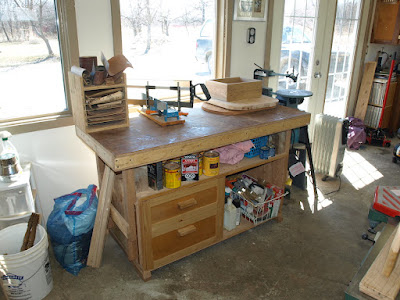Both collector and separator are outside my shop housed in a large shed attached to the workshop. This keeps the shop quite and my lungs away from the fine sawdust particles that escape the filter bag. A switch is located on the inside of the shop to turn the system on and off. You could also use wireless remote. My setup causes a negative pressure in the shop which can be bothersome in the winter as it draws the cold air into the shop. I'll live with it.
I checked building material recyclers for ducting first then picked up the rest from the local building supply. Watch prices as they vary widely on this stuff.
 |
| In this photo you can see some of the duct work for my setup |
Little or no flex hose, they mess up the airflow.
Rework pickup boots from 4" to fit 6" duct.(I'm doing the jointer and planer next)
Combine 2 adjustable 90's to create swept 90's. (set each at 45 degrees).
Y Pipes no Tee's
Connect pipes using pop rivets, long chips can get caught on screw tips.
The way in which my Y pipes are oriented to my drops is a bit of a problem. When you use a machine that is down stream of the previous Y pipe some of the chips will fall into the drops and begin to pile up on top of the closed blast gates. I just open those upstream gates to get rid of the chips before I shut down the collector.
I was unable to find 6" blast gates readily available so I made them myself using coffee cans and plywood. I got the idea from this video on Youtube. I used a jig saw to cut out the circles in the plywood.










